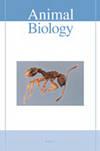Oviposition preference of pink bollworm, Pectinophora gossypiella on cotton
IF 0.9
4区 生物学
Q2 ZOOLOGY
引用次数: 1
Abstract
The effect of four cultivated species of cotton on the oviposition behaviour and/or preference of pink bollworm, Pectinophora gossypiella was studied under laboratory conditions. Blends of volatile organic compounds from squares of all four species of cotton (Gossypium arboreum, G. herbaceum, G. hirsutum, G. barbadense) were identified using gas chromatography-mass spectroscopy (GC-MS). Differences were observed across the species with respect to the relative proportion of identified compounds, viz., pinene, carene, caryophyllene, humulene and γ terpinene. In order to evaluate the ovipositional preference of pink bollworm, a series of no-choice and choice experiments were conducted using square extract, artificial blend-treated muslin cloth and cotton twig as substrate for oviposition. All four species of cotton had differences in the volatile blend composition that were reflected in the mean number of eggs laid under no-choice and choice experiments. A substantially higher number of eggs was laid on cotton twig under both no-choice and choice experiments than on square extract and artificial blend treatments. In both no-choice and choice experiments G. herbaceum was found to be the least preferred for egg laying compared to the other three species.粉红棉铃虫对棉花的产卵偏好
在室内条件下,研究了4种棉花栽培品种对棉铃虫产卵行为和偏好的影响。采用气相色谱-质谱联用技术(GC-MS)对4种棉花(Gossypium arboreum, G. herbaceum, G. hirsutum, G. barbadense)中挥发性有机物的共混物进行了鉴定。不同物种间的差异在于鉴定出的化合物,即蒎烯、蒈烯、石竹烯、葎草烯和γ萜烯的相对比例。为评价粉棉铃虫的产卵偏好,以方提取液、人工混纺棉布和棉枝为产卵基质,进行了一系列无选择和选择试验。四种棉花的挥发性混合成分存在差异,这反映在无选择和选择试验的平均产卵数上。无选择试验和选择试验的棉花枝产卵量均显著高于正方形提取液和人工混合处理。在无选择实验和选择实验中发现,与其他三种物种相比,草芽孢杆菌是最不适合产卵的。
本文章由计算机程序翻译,如有差异,请以英文原文为准。
求助全文
约1分钟内获得全文
求助全文
来源期刊

Animal Biology
生物-动物学
CiteScore
2.10
自引率
0.00%
发文量
34
审稿时长
3 months
期刊介绍:
Animal Biology publishes high quality papers and focuses on integration of the various disciplines within the broad field of zoology. These disciplines include behaviour, developmental biology, ecology, endocrinology, evolutionary biology, genomics, morphology, neurobiology, physiology, systematics and theoretical biology. Purely descriptive papers will not be considered for publication.
Animal Biology is the official journal of the Royal Dutch Zoological Society since its foundation in 1872. The journal was initially called Archives Néerlandaises de Zoologie, which was changed in 1952 to Netherlands Journal of Zoology, the current name was established in 2003.
 求助内容:
求助内容: 应助结果提醒方式:
应助结果提醒方式:


